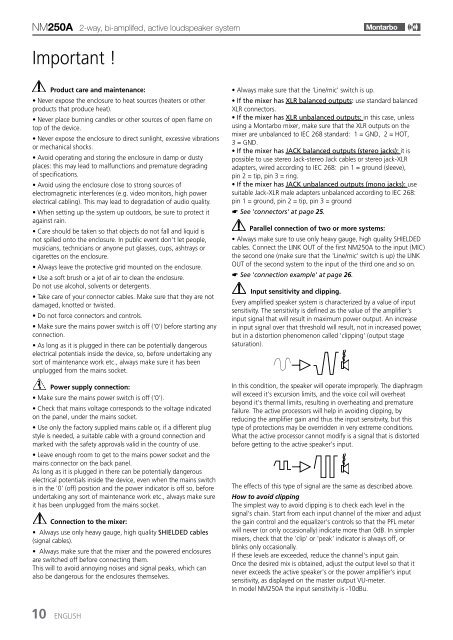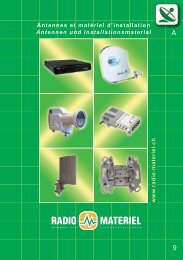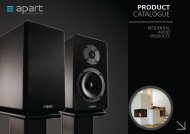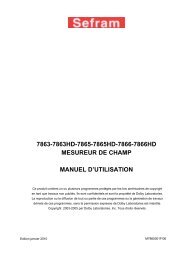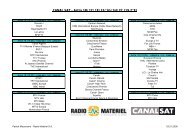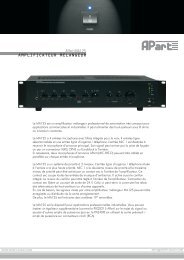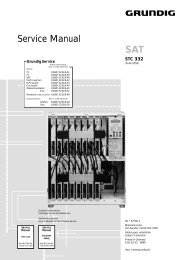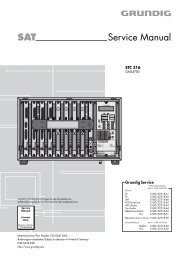Mode d'emploi - Radio Matériel
Mode d'emploi - Radio Matériel
Mode d'emploi - Radio Matériel
You also want an ePaper? Increase the reach of your titles
YUMPU automatically turns print PDFs into web optimized ePapers that Google loves.
NM250A 2-way, bi-amplifed, active loudspeaker system<br />
Important !<br />
Product care and maintenance:<br />
• Never expose the enclosure to heat sources (heaters or other<br />
products that produce heat).<br />
• Never place burning candles or other sources of open flame on<br />
top of the device.<br />
• Never expose the enclosure to direct sunlight, excessive vibrations<br />
or mechanical shocks.<br />
• Avoid operating and storing the enclosure in damp or dusty<br />
places: this may lead to malfunctions and premature degrading<br />
of specifications.<br />
• Avoid using the enclosure close to strong sources of<br />
electromagnetic interferences (e.g. video monitors, high power<br />
electrical cabling). This may lead to degradation of audio quality.<br />
• When setting up the system up outdoors, be sure to protect it<br />
against rain.<br />
• Care should be taken so that objects do not fall and liquid is<br />
not spilled onto the enclosure. In public event don't let people,<br />
musicians, technicians or anyone put glasses, cups, ashtrays or<br />
cigarettes on the enclosure.<br />
• Always leave the protective grid mounted on the enclosure.<br />
• Use a soft brush or a jet of air to clean the enclosure.<br />
Do not use alcohol, solvents or detergents.<br />
• Take care of your connector cables. Make sure that they are not<br />
damaged, knotted or twisted.<br />
• Do not force connectors and controls.<br />
• Make sure the mains power switch is off ('0') before starting any<br />
connection.<br />
• As long as it is plugged in there can be potentially dangerous<br />
electrical potentials inside the device, so, before undertaking any<br />
sort of maintenance work etc., always make sure it has been<br />
unplugged from the mains socket.<br />
Power supply connection:<br />
• Make sure the mains power switch is off ('0').<br />
• Check that mains voltage corresponds to the voltage indicated<br />
on the panel, under the mains socket.<br />
• Use only the factory supplied mains cable or, if a different plug<br />
style is needed, a suitable cable with a ground connection and<br />
marked with the safety approvals valid in the country of use.<br />
• Leave enough room to get to the mains power socket and the<br />
mains connector on the back panel.<br />
As long as it is plugged in there can be potentially dangerous<br />
electrical potentials inside the device, even when the mains switch<br />
is in the '0' (off) position and the power indicator is off so, before<br />
undertaking any sort of maintenance work etc., always make sure<br />
it has been unplugged from the mains socket.<br />
Connection to the mixer:<br />
• Always use only heavy gauge, high quality SHIELDED cables<br />
(signal cables).<br />
• Always make sure that the mixer and the powered enclosures<br />
are switched off before connecting them.<br />
This will to avoid annoying noises and signal peaks, which can<br />
also be dangerous for the enclosures themselves.<br />
• Always make sure that the 'Line/mic' switch is up.<br />
• If the mixer has XLR balanced outputs: use standard balanced<br />
XLR connectors.<br />
• If the mixer has XLR unbalanced outputs: in this case, unless<br />
using a Montarbo mixer, make sure that the XLR outputs on the<br />
mixer are unbalanced to IEC 268 standard: 1 = GND, 2 = HOT,<br />
3 = GND.<br />
• If the mixer has JACK balanced outputs (stereo jacks): it is<br />
possible to use stereo Jack-stereo Jack cables or stereo jack-XLR<br />
adapters, wired according to IEC 268: pin 1 = ground (sleeve),<br />
pin 2 = tip, pin 3 = ring.<br />
• If the mixer has JACK unbalanced outputs (mono jacks): use<br />
suitable Jack-XLR male adapters unbalanced according to IEC 268:<br />
pin 1 = ground, pin 2 = tip, pin 3 = ground<br />
See 'connectors' at page 25.<br />
Parallel connection of two or more systems:<br />
• Always make sure to use only heavy gauge, high quality SHIELDED<br />
cables. Connect the LINK OUT of the first NM250A to the input (MIC)<br />
the second one (make sure that the 'Line/mic' switch is up) the LINK<br />
OUT of the second system to the input of the third one and so on.<br />
See 'connection example' at page 26.<br />
Input sensitivity and clipping.<br />
Every amplified speaker system is characterized by a value of input<br />
sensitivity. The sensitivity is defined as the value of the amplifier's<br />
input signal that will result in maximum power output. An increase<br />
in input signal over that threshold will result, not in increased power,<br />
but in a distortion phenomenon called 'clipping' (output stage<br />
saturation).<br />
In this condition, the speaker will operate improperly. The diaphragm<br />
will exceed it's excursion limits, and the voice coil will overheat<br />
beyond it's thermal limits, resulting in overheating and premature<br />
failure. The active processors will help in avoiding clipping, by<br />
reducing the amplifier gain and thus the input sensitivity, but this<br />
type of protections may be overridden in very extreme conditions.<br />
What the active processor cannot modify is a signal that is distorted<br />
before getting to the active speaker's input.<br />
The effects of this type of signal are the same as described above.<br />
How to avoid clipping<br />
The simplest way to avoid clipping is to check each level in the<br />
signal's chain. Start from each input channel of the mixer and adjust<br />
the gain control and the equalizer's controls so that the PFL meter<br />
will never (or only occasionally) indicate more than 0dB. In simpler<br />
mixers, check that the 'clip' or 'peak' indicator is always off, or<br />
blinks only occasionally.<br />
If these levels are exceeded, reduce the channel's input gain.<br />
Once the desired mix is obtained, adjust the output level so that it<br />
never exceeds the active speaker's or the power amplifier's input<br />
sensitivity, as displayed on the master output VU-meter.<br />
In model NM250A the input sensitivity is -10dBu.<br />
10 ENGLISH


